- Climate Change
- Posted
Terra incognita
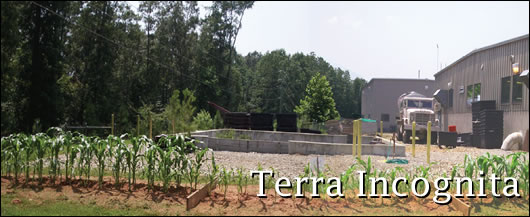
Much hope has been pinned on the development of new technologies for sinking carbon and generating low impact energy. Richard Douthwaite reveals the major contribution that could be offered by something very old; a soil type that has been in use for 6,000 years.
The eight-year-long battle over plans to build an incinerator to burn off municipal waste at Poolbeg in Dublin may be in its final stages. An Bord Pleanála, which received over 3,000 written objections to the project, is in the process of conducting a public oral hearing into it at Croke Park (such is the level of public interest) as we go to press. If it finally rejects the current proposal for a e250m plant to burn 600,000 tonnes of waste a year, its decision will drive a stake through the heart of any further plans for incineration in the Dublin area and, probably, in Ireland as a whole.
This would be welcome. Incineration is a crude, outmoded, polluting technology and cheaper waste treatment methods are becoming available which would make much better use of the organic matter we throw away. The thousands of people in Dublin, Louth, Cork, Monaghan and Meath who refused to accept a bad technology should be thanked for having preserved the space in which the better ones can be used.
You could argue that the most important thing about the emerging technologies is the role they can play in limiting climate change and in increasing soil fertility. Let me explain. So far, the public debate in climate change has centred on the need to reduce carbon dioxide emissions from burning fossil fuels. Almost nothing has been said about tackling another major source of CO2 emissions - changes in land use - although a lot of scientists are working in the area.
At present, around 24 billion tonnes of CO2 are released each year by the worldwide burning of fossil fuels whereas the clearing of land and the loss of carbon from forests, bogs and the soil adds a further 5.9 billion tonnes, making a total of 30 billion tonnes a year. In other words, about a fifth of all CO2 emissions is due to the way we treat - or mistreat - the land.
There are even fears that efforts to bring down emissions from fossil fuel use will increase emissions from land use changes. The current drive to produce more biofuels is already leading to the destruction of large areas of tropical forest to make way for the planting of oil palms to produce biodiesel. The amount of carbon released into the atmosphere when the forests are burned will take many years to offset through the biodiesel use.
According to Friends of the Earth, the development of oil-palm plantations was responsible for an estimated 87 per cent of deforestation in Malaysia between 1985 and 2000 while in Indonesia, according to Greenpeace, an area of forest equivalent to 300 football pitches was destroyed every hour between 2000 and 2005. That amounts to 2 million hectares each year. The country has lost 72 percent of its intact ancient forests and half of what remains is threatened by commercial logging, forest fires and clearances for palm oil plantations.
Some scientists are even claiming that land surface changes like urban sprawl, deforestation and reforestation, and agricultural and irrigation practices may be having a greater impact on the climate than are carbon dioxide emissions. Professor Roger Pielke, Sr., of Colorado State University led a 2002 NASA-funded study into the ways in which land surface changes redistribute heat regionally and globally within the atmosphere. He believes that landcover changes over the past 300 years "may have already altered the climate more than would occur associated with the radiative effect of a doubling of carbon dioxide."
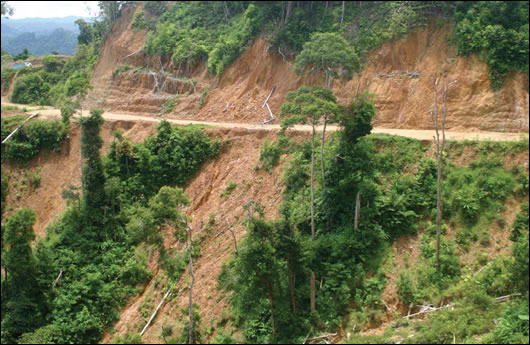
He points out that types of land surface strongly influence how the Sun's energy is distributed back to the atmosphere. For example, if a rainforest is removed and replaced with crops, less water is transpired from the plants' leaves. Less transpiration leads to warmer temperatures in the area. On the other hand, if farmland is irrigated, more water is transpired and also evaporated from moist soils. This cools and moistens the atmosphere, and can affect rainfall and cloudiness.
Certainly, preventing harmful land changes would be a major step in limiting the amount the world warms. There's a general agreement that allowing the average global temperature to rise by more than two degrees Celsius above its level in pre-industrial times would be extremely damaging. Overshooting that mark could even initiate a runaway warming in which stressed, dried out forests burned and released the carbon they contained, Methane, which has 20 times the warming effect of CO2, was released in vast quantities as the world's largest frozen peat bog melted in western Siberia. The fear of this happening was one of the reasons the EU set 2°C as its maximum temperature-rise target.
If one asks how many more billions of tonnes of CO2 can be released before that temperature target becomes unachievable, one can see how important the land-use-change emissions are to the answer. Table 1(below) is adapted from the Stern Review. It presents the results of eleven recent studies, the most pessimistic of which says that there is only a 22% chance of staying below the target temperature if the concentration of CO2 in the atmosphere exceeds 400 parts per million. The current (2007) concentration of CO2 is 383ppm, 105 ppm above the pre-industrial average, and is rising at about 1.5ppm every year. So, at that rate, the 400ppm level will be reached in about 12 years.
Another way of working out how much = time we've got to save the situation is to do a simple proportions sum. As approximately 3,000 billion tonnes of CO2 are already in the atmosphere and this weight gives 383ppm, it's easy to work out that the rise to 400ppm only requires the addition of 133 billion tonnes. Fortunately, roughly half of the 30 billion tonnes released each year is absorbed by plants and the sea, but that still leaves an extra 14 billion tonnes going into the atmosphere annually. In other words, if emissions continue at their current rate, we can expect to add at least the 133 billion tonnes in around ten years.
Both calculations therefore indicate that we will pass the 400ppm point within the next ten or twelve years unless serious cuts are rapidly made in the level of emissions. It's going to be very difficult to check emissions from fossil fuel use significantly in that time. What are the prospects for cutting emissions from changes in land use? Or even sequestering large quantities of carbon in the soil so that the land becomes a net carbon sink rather than a source? After all, if either land use changes stopped, or releases in one place were balanced by the absorption of carbon in others, we'd only be adding 9 billion tonnes of CO2 to the atmosphere each year, and we'd have bought ourselves 50% more time.
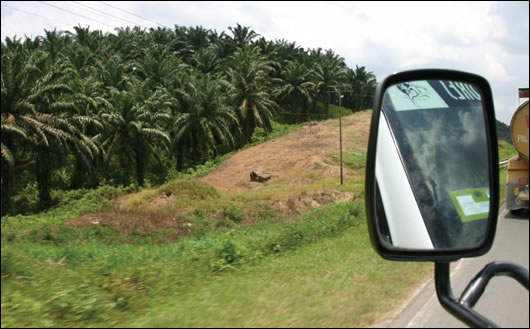
At the beginning of May, 150 people assembled in Terrigal, New South Wales, a two-hour drive from Sydney, to discuss technologies that might enable large quantities of carbon to be sequestered in the soil with dramatic effects. The conference was called by the International Agrichar Initiative, a newly-formed coalition of research, commercial and policy-oriented people and organisations concerned with the sustainability of the world's soils and with sustainable bio-energy production. "Agrichar" - I prefer the term "biochar" - is charcoal produced from organic waste and experiments have shown that if it is mixed with soil, plant growth is improved dramatically. This is because the char improves the soil's cation exchange capacity, enabling the plants to take up nutrients more easily, and because it binds nutrients to itself, preventing them leaching away. It also improves the water retention capability of the soil, neutralises soil acidity and significantly reduces the release of two important greenhouse gases, methane and nitrous oxide, when organic matter in the soil decays .
As if this was not enough, it has an even more important effect. The char encourages fungal growth in the soil. Some types of soil fungi grow because plants send sugars down to them through their roots and, in a symbiotic exchange, the fungi supply them with nutrients in return. In effect, by increasing the fungi in a biochar soil, the plants are sequestering carbon themselves. So, if a farmer put biochar on a field, the amount of carbon he or she was locking away (and charcoal can persist in soil for thousands of years) would not just be the tonnage they added. The plants would add to the total too, possibly =
continuing to do so for hundreds of years. Although it sounds too good to be true, it is claimed that soils containing char in the Amazonian basin known as terra preta (Portugese for 'dark earth') regenerates when it is dug up and sold as potting compost. What is certain is that these soils were created by the indigenous peoples of the area long before Columbus - some have been dated as far back as 6,000 years - and have maintained their fertility since then.
Everyone who is looking into biochar is excited by the prospect that it might be possible to set up a virtuous circle in which farmers put char on their fields, get bigger crops (and the increase in growth can be quite spectacular as the illustrations show) and then use some of the extra biomass they produce both as a renewable energy source and as a source of biochar to treat more fields. The world's biomass production could grow and more and more carbon could be sequestered each year by millions of farmers - and their plants - all around the world.
But what's the link between biochar and the Poolbeg incinerator? Two of the people who attended the Agrichar conference were Professor Michael Hayes of the University of Limerick and his son Daniel, who is researching a technology that produces energy and biochar from biomass at UL for his PhD. This technology, the Biofine process, would be ideal for use in Dublin. It could turn the waste into high quality motor fuel and leave a residue - biochar - which could be sold for soil improvement. The availability of char is really important because the best terra preta soils are 9% char and difficulties with getting the large tonnages required for treating even a small field have been holding back research projects, to say nothing of commercial-scale trials.
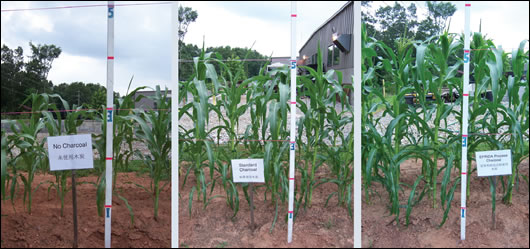
In the Biofine process, wastes such as vegetable matter, paper, cardboard, wood and sewage sludge are mixed with dilute sulphuric acid to form a slurry. This goes into a pressure cooker operating at about 200C where the acid breaks down the organic material into three main chemicals; furfural, levulinic acid, and lignin - the latter being the natural glue that holds wood together. The acid is recovered and recycled and the lignin is heated to turn it to char. Part of this char is then used in the famous water-gas reaction which everyone who studied chemistry at school will know. It is heated in a retort into which steam is injected and CO2 and hydrogen are produced. The rest of the char is available for sale.
After the furfural and the levulinic acid have been purified, they are treated with the hydrogen to make methyl tetrahydrofuran (MTHF), which can be added to petrol in small quantities to make it burn more cleanly or, in larger quantities, used as a substitute for petrol itself. It is claimed that a 60-40 MTHF/petrol mixture does not impair engine performance. Levulinic acid can also be turned into ethyl levulinate, a superior diesel fuel that produces much less soot and nitrous oxide than its conventional rival when used on the road. However, levulinic acid may be too valuable to burn at all since it can be turned into nylon and other polymers and into a range of solvents and detergents.
A pilot Biofine plant in South Glens Falls, New York, has been operating since 1998 and a 50-tonnes per day commercial plant which uses waste paper as its feedstock was completed in Caserta, near Naples, last year. The plan is to increase the size of the Caserta plant to 300-tonnes a day, about a fifth of the size that would be required in Dublin. This raises the question of whether the technology is sufficiently mature yet to be adopted there.
"Incineration of any organic material is a great waste of a resource, and every effort should be made to stop the incineration of anything apart from hazardous waste" Professor Hayes says. "The various types of so-called waste must be separated at source, of course, but it =
was clear from the Agrichar conference that it will be possible to develop charification and gasification alternatives to incineration. To us Biofine is the best alternative and the levulinic acid product makes chemical sense."
As Hayes indicates, Biofine is not the only proprietary technology that can take organic waste and produce char, but it has the advantage that since it is not burning anything, it does not need its feedstock to be dry. It would be able to dispose of sewage sludge, a role which was proposed for the Poolbeg incinerator as its site is close to the city's treatment works at Ringsend, but this would almost certainly contaminate the char with heavy metals, which would make it unsuited for use on the land.
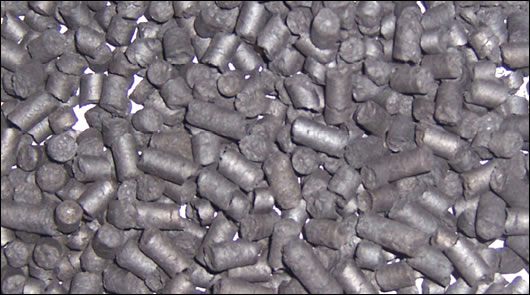
Nevertheless, siting a Biofine plant near a sewage works could provide a way of recycling back to the land the plant nutrients we currently flush away. Folke Gunther, the Swedish researcher I've mentioned before in Construct Ireland, believes that if you add a lot of fresh char to soil, its fertility might temporarily decrease. This would be because the nutrients already in the soil might be adsorbed by the char's massive surface area, which is exactly what happens when activated charcoal is used in filters to remove odours or colours from liquids. Gunther thinks that only when the charcoal is full of nutrients and soil micro-organisms will the plants be able to feed on them. He therefore suggests the char should be saturated with nutrients before it is added to the soil by mixing it with compost, manure, or urine. "This was done by the Indians when the original terra preta soils were created" he says.
This pre-treatment approach has been adopted by Eprida, another biomass conversion technology, which turns plant material into hydrogen and char. Part of the hydrogen is converted to ammonia and when that is combined with the char as a catalyst, it takes in carbon dioxide from power-station flue gases to create a carbon-rich slow-release ammonium bicarbonate fertiliser. "When used to produce a 10% commercial nitrogen fertilizer, each ton of hydrogen effectively sequesters 12.7 tons of carbon dioxide" says Danny Day, who invented the process.
Gunther is working with other members of Feasta to devise a system to reward millions of landowners around the world for maintaining and increasing the carbon content of their soils. "It shouldn't just be big companies who are rewarded for sequestering carbon" he says. "We can only start bringing emissions down if we can generate a mass movement."
Daniel Hayes, who recently surveyed the published information on the technologies for converting biomass into chemicals and fuels, points out that bigger Biofine plants are better value. "A 1000 ton per day facility may cost around $150m while a 200 ton per day facility may cost more than half that" he says.
According to Dr. Stephen F. Paul of Princetown University, the capital cost of a Biofine plant is around half that of a typical "Waste-to-Energy" incinerator. And, when you compare the value of the Biofine products with those of the incinerator - just heat and ash - it's clear that it's a much more profitable technology. Large EU demonstration grants would almost certainly be available for building one to handle Dublin's waste but, in view of the small scale of the existing Biofine plants, will anyone have the guts and the vision to go ahead?
Folke Gunther will be taking part in a Feasta seminar on the inclusion of carbon in soils at the Great Green Gathering, Woodbrook House, Killanne, Enniscorthy, Co. Wexford, on Saturday, 18 August, 2007.
Details from This email address is being protected from spambots. You need JavaScript enabled to view it.
Related items
-
 Editor's letter: Issue 30
Editor's letter: Issue 30 -
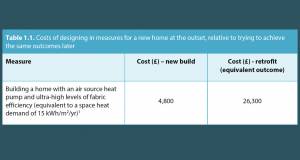 New housing should be to passive house standard — Climate Change Committee
New housing should be to passive house standard — Climate Change Committee -
 Future proof: designing buildings that withstand climate change
Future proof: designing buildings that withstand climate change -
 Passive House Institute founder calls for action on climate change
Passive House Institute founder calls for action on climate change -
Green groups criticse new EU energy efficiency plan
-
US energy secretary to speak in Dublin on Friday
-
NUI Galway launches degree in energy systems engineering
-
Irish business leaders back green procurement
-
Green business leaders to sign open letter to government
-
BER assessors association to host AGM in Dublin
-
Increase in energy use in Irish buildings despite recession
-
Engineers urge government to act on climate change

